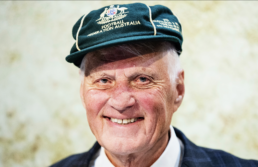These life stories may contain descriptions of childhood trauma and abuse, as well as images, voices and names of people now deceased. If you need help, you can find contact details for some relevant support services on our support page.
Bosnian-born Australian soccer player and coach, Rale Rasic (1935-2023), grew up in an orphanage.
Rale Rasic was the second of four children born to Stanislava and Ivan Rasic in what was then the Kingdom of Yugoslavia. Rale knows little about his parents and has no memories of them.
I can’t even remember the faces of my parents. I don’t have photographs or mementos because most of our possessions were destroyed; my parents’ lives are somewhat of a mystery to me (Gatt, 16).
Rasic does have dim but loving memories of an uncle, but when his uncle died in 1945, he “was whisked off to a local orphanage, which was home to about 30 children”.
The children were separated; the two girls were sent to different orphanages and his brother, Dragoslav, who was born in 1944, was adopted.
My parents seemed to disappear from the face of the earth and I learned later that my mother had been brutally beaten and died in 1945…(Gatt, 18).
Rasic and the other children were evacuated from the orphanage during WWII and sent to Centralni Lazaret orphanage in Belgrade, the capital of Yugoslavia.
[Orphanages] are supposed to be grim, desperate, hellholes for the unwanted, misfits and the like. But let me tell you, this was almost paradise on earth for me…I was given new clothes, sit-down meals and was able to take showers with soap. What a luxury! (Gatt, 18-19).
Rasic stayed in the orphanage until he was seventeen. He grew up playing soccer, and was drafted into a professional team at the age of thirteen.
In 1953, Rasic was selected “along with fellow orphan, Mihajlo Djuricin” for the national under-18 team, and again in 1954. He was then invited to join the senior team for the province of Vojvodina.
At the age of twenty-six, Rasic made the decision to move to Australia but was not in Melbourne long before he was called home to complete national service. While in the army he completed his university degree in education.
Rasic returned to Australia in 1966. Four years later he took up a position as coach of the national soccer team, the Socceroos. He is fondly remembered as the first coach to take the team to the World Cup in 1974 and owns a considerable collection of memorabilia from the event.
I’m very proud of the country and to be the first team from the country to achieve World Cup qualification… There were six different nationalities that I had in the team and they all proudly sang the national anthem (Stamocostas).
After the World Cup, Rasic continued coaching soccer (but not the Socceroos) and went on to become a television presenter during 2006 World Cup, was inducted into the Sport Australia Hall of Fame in 1989, and was awarded an Order of Australia medal for services to sport in 2004.
Rale Rasic died in Sydney on 8 June 2023. Amongst many accolades was this from the Prime Minister of Australia, Anthony Albanese:
Rale had a passion for education and a great instinct for bringing out the best in his players. He set new standards for professionalism, fitness and commitment and achieved groundbreaking success.
References:
Gatt, Ray. The Rale Rasic Story. Sydney: New Holland, 2006.
“Rale Rasic OAM.” Media Statement, Prime Minister of Australia, 9 June 2023. https://www.pm.gov.au/media/rale-rasic-oam
Stamocostas, Con. “Does Rale Rasic House the Best Private Collection of Football Memorabilia in Australia?” FTBL Website, 2018. https://www.ftbl.com.au/news/does-rale-rasic-house-the-best-private-collection-of-football-memorabilia-in-australia-489697
Image available here.
